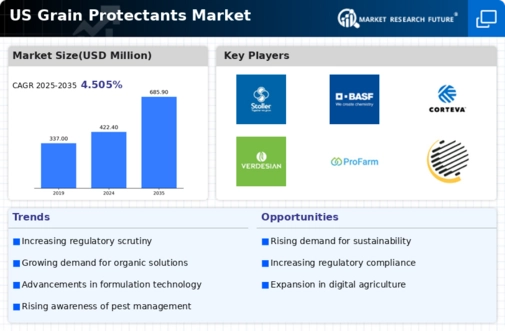The US Grain Protectants Market has experienced significant growth in recent years, driven by increasing demand for effective solutions to combat pests and fungi that compromise grain quality during storage. This competitive landscape features a variety of industry players striving to innovate and develop advanced protectant products to meet the evolving needs of agricultural producers. The market is characterized by strategic collaborations, product launches, and technological advancements as companies aim to enhance their offerings and ensure the long-term viability of stored grains.
The competitive insights into this market reveal a dynamic environment where firms leverage their research capabilities and customer-centric approaches to establish strong footholds across different regions of the United States. The awareness of safe and effective agricultural practices also highlights the necessity for tailored solutions in this sector, ensuring that businesses stay relevant and competitive.FMC Corporation stands out in the US Grain Protectants Market with a strong presence due to its extensive portfolio and commitment to innovation.
The company leverages its expertise in agricultural science to offer a range of products that effectively protect grains from damage caused by insects, molds, and other threats. FMC Corporation's strengths lie in its advanced research capabilities, allowing for the continual development of novel solutions that align with the latest industry standards and farmer needs. Additionally, the company's focus on sustainability and customer service has fostered lasting relationships with its clients, ultimately enhancing brand loyalty and market share.
Furthermore, FMC Corporation engages in strategic partnerships and collaborations that reinforce its competitive positioning and facilitate access to emerging markets within the grain protection sphere.Stoller USA extends its influence in the US Grain Protectants Market by providing innovative seed treatment technologies and nutrient solutions that enhance crop resilience and storage efficacy. The company specializes in biological and nutritional products that support crop health, ultimately improving grain quality and protection during storage.
Stoller USA’s strength lies in its dedication to research and development, which has led to the introduction of key products aimed at addressing specific agronomic challenges faced by grain producers. With a strong focus on customer education and support, Stoller USA has cultivated a robust market presence, making it a trusted partner for many farmers across the United States. The company has also engaged in strategic mergers and acquisitions to enhance its product offerings, thereby maintaining a competitive edge in the grain protectants sector.
By aligning its innovative solutions with the pressing needs of grain storage and protection, Stoller USA continues to strengthen its position in the market.





















